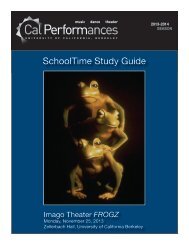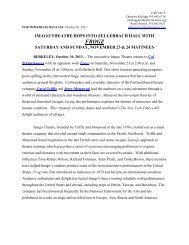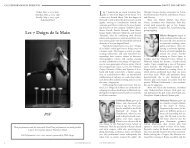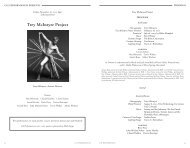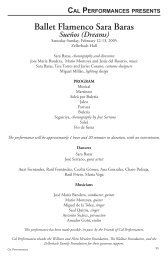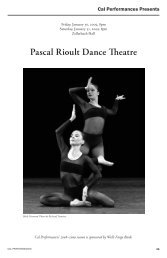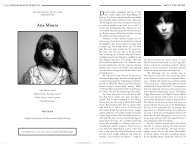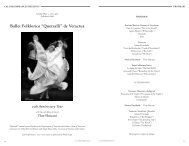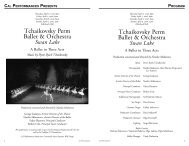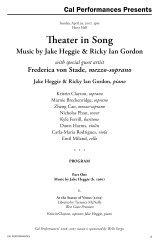Bayanihan Philippine National Dance Company - Cal Performances
Bayanihan Philippine National Dance Company - Cal Performances
Bayanihan Philippine National Dance Company - Cal Performances
You also want an ePaper? Increase the reach of your titles
YUMPU automatically turns print PDFs into web optimized ePapers that Google loves.
PROGRAM<br />
8<br />
Malageuña de Bailes<br />
Sacramonte de Intramuros<br />
Cancion<br />
Habanero de dilao<br />
El Cañi<br />
The <strong>Philippine</strong>scape<br />
The rhythms and colors of the <strong>Philippine</strong>s. This suite is a fitting finale, celebrating the spirit of the Filipinos<br />
in their love of tradition, nature, and the environment. It includes <strong>Bayanihan</strong>’s tribute to the master,<br />
<strong>National</strong> Artist Fernando Amorsolo, who gave life to the <strong>Philippine</strong> countryside and beautiful traditions<br />
in his masterpieces. <strong>Dance</strong>s inspired by the studies done in partnership with the local governments of<br />
General Trias and Noveleta, Cavite, and Iloilo are recreated in this extravagant finale.<br />
Musicians<br />
Timoteo Basco<br />
Dominic Glenn Cruz<br />
Rommel de la Cruz<br />
Jose Laurence Leong<br />
Rudolf S. Pabon<br />
Rogelio C. Sambrano Jr.<br />
Jezreel Lastra<br />
Singer<br />
Mary Anne Luis<br />
Female <strong>Dance</strong>rs<br />
Marielle M. Benitez<br />
Pamela Rose Corales<br />
Charisse Cabera<br />
Rachel Dawn Cudiamat<br />
Amorsolo<br />
Kasilyo<br />
Kawayanan<br />
Ang Maya<br />
Fiesta Extravaganza<br />
The program is subject to change.<br />
CAST<br />
Leonor Petra Elepano<br />
Karina Gabito<br />
Louis Belle Ignacio<br />
Mary Anne Luis<br />
Male <strong>Dance</strong>rs<br />
Ferdinand Orbacedo<br />
Peter Laurenz <strong>Cal</strong>langan<br />
Peter Laurent <strong>Cal</strong>langan<br />
Michael de la Chica<br />
Paulo Emmanuel Garcia<br />
Leo Laurence Q. Lorilla<br />
Joseph Robert Manayan<br />
Gian Carlo Yabut<br />
Hubbert Cristian Guerrero<br />
Corrigidor Reche Obillo<br />
CAL PERFORMANCES<br />
<strong>Bayanihan</strong>: A <strong>National</strong> Treasure<br />
The <strong>Bayanihan</strong> story spans 43 years of performances<br />
the world over. It had its early roots in the<br />
Filipiniana Folk Music and <strong>Dance</strong> Committee of<br />
the <strong>Philippine</strong> Women’s University (PWU). In<br />
1957, the PWU <strong>Bayanihan</strong> Folk Arts Center and its<br />
performing arm, the <strong>Bayanihan</strong> <strong>Philippine</strong> <strong>Dance</strong><br />
<strong>Company</strong>, were founded by Dr. Helena Z Benitez<br />
to conduct research in ethnic rites, tribal folklore,<br />
and regional folkways; to collect indigenous art<br />
forms as expressed in music, dance, literature, arts,<br />
and crafts; to distill and transform these cultural<br />
traditions into theatrical presentations; and to<br />
promote international understanding through cultural<br />
exchange and performances abroad.<br />
The <strong>Company</strong> takes its name from the ancient<br />
Filipino tradition of <strong>Bayanihan</strong>, which signifies<br />
working together for the common good. It is this<br />
spirit of togetherness that bonded parents, teachers,<br />
researchers, technicians, dancers, and musicians,<br />
working as one to achieve the objectives of<br />
the <strong>Company</strong>.<br />
As a civic response to a government appeal<br />
for a cultural program for the country’s participation<br />
in the 1958 Brussels World’s Fair, <strong>Bayanihan</strong><br />
mounted a production titled Glimpses of <strong>Philippine</strong><br />
Culture Through Music and <strong>Dance</strong>, which proved<br />
to be the sensation of the Fair and was featured on<br />
Ed Sullivan’s national U.S. television broadcast of<br />
World’s Fair highlights.<br />
A year later, noted impresario Sol Hurok contracted<br />
<strong>Bayanihan</strong> for his annual International<br />
<strong>Dance</strong> Festival. Making its Broadway debut at<br />
the Winter Garden Theater on October 13, 1959,<br />
<strong>Bayanihan</strong> received the unanimous acclaim of New<br />
York critics—a feat which earned the <strong>Company</strong> the<br />
affectionate title “Cinderella of <strong>Dance</strong> Theater.”<br />
Critics were particularly impressed by the dancers’<br />
skill, grace, and joie de vivre, as well as by the<br />
<strong>Company</strong>’s success in transferring indigenous<br />
dance and music traditions from their ancient origins<br />
in the countryside to the confines of the stage<br />
without sacrificing authenticity. Said The New York<br />
Herald Tribune: “<strong>Bayanihan</strong> is one of the newest<br />
examples of an ethnic dance culture which has<br />
gone beyond simple preservation (important as<br />
that is), and into creative growth.”<br />
CAL PERFORMANCES<br />
ABOUT THE ARTISTS<br />
Since 1958, <strong>Bayanihan</strong> has mounted 15 largescale<br />
international tours and over a hundred brief<br />
tours to international events and festivals, covering<br />
55 countries on 5 continents. The first Filipino<br />
group to perform on Broadway, <strong>Bayanihan</strong> also<br />
has the distinction of being the first non-American<br />
dance company to take to the stage at New York’s<br />
Lincoln Center for the Performing Arts, as well<br />
as the first <strong>Philippine</strong> cultural group to perform<br />
in Russia, the People’s Republic of China, and<br />
throughout South America. As official <strong>Philippine</strong><br />
representative at the first CIOFF World Folkloriada,<br />
held in the Netherlands in 1996, <strong>Bayanihan</strong> was<br />
one of the top five performing arts groups chosen<br />
from among 70 national groups to give repeat<br />
performances at the close of the festival. In<br />
1998, <strong>Bayanihan</strong> commenced a centennial tour of<br />
Europe at the Lisboa World Expo, followed by performances<br />
in Monaco, Germany, France, Madrid,<br />
and in 16 cities in Galicia, northwest Spain.<br />
Other significant accolades include the 1965<br />
Ramon Magsaysay Award for International<br />
Understanding; the 1960 Théâtre des Nations<br />
Award (folk dance category); 1978 and 1989<br />
Program for Asian Projects grants awarded by the<br />
Rockefeller Brothers Fund/Ramon Magsaysay<br />
Foundation; and first prize (traditional costumes<br />
category at the the 54th Almond in Blossom<br />
Festival and 44th International Folk Festival in<br />
Sicily in 1999.<br />
<strong>Bayanihan</strong> has awakened a new pride among<br />
Filipinos in their cultural heritage, preserved and<br />
added a new dimension to the country’s dance tradition,<br />
and amassed a rich reserve of international<br />
goodwill. <strong>Bayanihan</strong>’s example has encouraged<br />
the growth of numerous folk dance companies<br />
throughout the country, some of them organized<br />
by former <strong>Bayanihan</strong> dancers. The <strong>Company</strong> has<br />
also inspired other countries to exploit their own<br />
folk material for international presentation. Among<br />
these is Mexico, whose folkloric ballet group was<br />
formed after <strong>Bayanihan</strong>’s first performances there.<br />
In 2000, by an act of Congress, <strong>Bayanihan</strong><br />
was officially designated the <strong>National</strong> Folk <strong>Dance</strong><br />
<strong>Company</strong> of the <strong>Philippine</strong>s. Recent activities<br />
include performances in Spain, England, and<br />
Holland in 2004, as well as performances at the<br />
Universal Forum on Culture in Barcelona and a<br />
9



